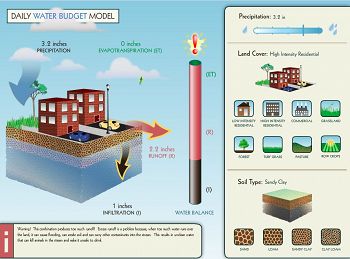Gill et al., 2014
Model My Watershed: Connecting Students’ Conceptual Understanding of Watersheds to Real-World Decision Making
Gill, S. E., N. Marcum-Dietrich, and R. Becker-Klein (2014)
J. Geosci. Educ. 62 (1): 61–73
Abstract
The Simple Hydrologic Model allows students to manipulate variables, such as storm intensity, land cover type, and soil texture, and to view the water budget, which partitions the rainfall into evapotranspiration, runoff, and infiltration.
The Model My Watershed (MMW) application, and associated curricula, provides students with meaningful opportunities to connect conceptual understanding of watersheds to real-world decision making. The application uses an authentic hydrologic model, TR-55 (developed by the U.S. Natural Resources Conservation Service), and real data applied in selected communities in southeastern Pennsylvania.
The study investigates whether MMW is an effective tool for increasing students’ understanding of watersheds and the impact of human decisions on local watershed conditions. While statistically significant learning gains were measured, most students failed to reach the highest levels of watershed understanding. Further refinement of the MMW curricula is needed to help students trace water along multiple pathways and to enable them to trace the connections among groundwater, surface water, and atmospheric water vapor.
Citation
Gill, S. E., N. Marcum-Dietrich, and R. Becker-Klein (2014): Model My Watershed: Connecting Students’ Conceptual Understanding of Watersheds to Real-World Decision Making. J. Geosci. Educ. 62 (1): 61–73. DOI: 10.5408/12-395.1
Explore Further

